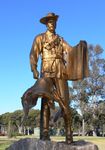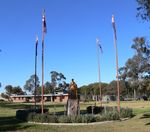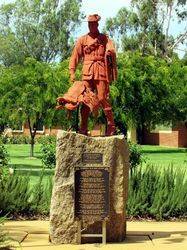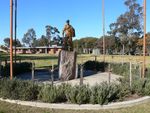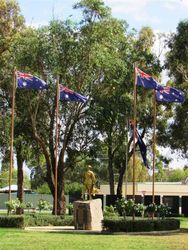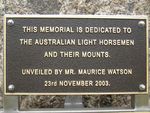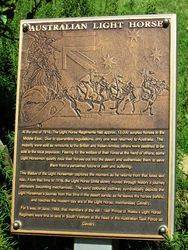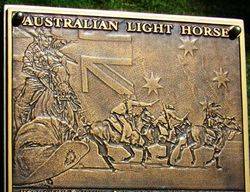
Home » Themes » Conflict » World War One
Light Horse MemorialPrint Page 
In November 2003 a monument to the 24 Australian Light horse regiments and their horses was unveiled by Maurice Watson, aged 84, the last Light Horseman, who enlisted from Tongala.
The statue, standing two metres, is of a horseman carrying an empty saddle, bridle and saddle cloth, walking away, head lowered. On a plaque beneath the statue is the poem Farewell Old War Horse, a tribute to the 120,000 Australian waler horses that went overseas in the First World War.
Due to quarantine restrictions, only one horse returned to Australia, "Sandy", the mount of Major-General W.T. Bridges, who died at Gallipoli in May 1915.
Location
| Address: | Mangan Street, Sound Shell Park , Tongala, 3621 |
|---|---|
| State: | VIC |
| Area: | AUS |
| GPS Coordinates: | Lat: -36.249975 Long: 144.948781 Note: GPS Coordinates are approximate. |
Details
| Monument Type: | Monument |
|---|---|
| Monument Theme: | Conflict |
| Sub-Theme: | WW1 |
| Actual Event Start Date: | 04-August-1914 |
| Actual Event End Date: | 28-June-1919 |
Dedication
| Actual Monument Dedication Date: | Sunday 23rd November, 2003 |
|---|
Plaque :
This memorial is dedicated to the Australian Light Horsemen and their mounts.
Unveiled by Mr. Maurice Watson
23 November 2003
Plaque :
Farewell Old War Horse
This poem refers to WWI and is inspired by feelings of Australian Light Horsemen who, because of quarantine regulations, had to leave their horses in the Middle East on their return to Australia. (author unknown)
The struggle for freedom has ended they say, The days of fatigue and remorse, But our hearts one and all are in memory today, We are losing our old friend, the Horse.
The old quadruped that has carried us thro' The sand ridden caravan track and shared in the charge of the gallant and true With the boys who will never come back.
Oh those long weary days thro' a miniature hell short of water and nothing to eat, each hour we climbed down for a few minutes spell and dozed safe and sound at your feet.
When the enemy shrapnel broke overhead, as we passed up that Valley of Death, You never once slackened in the hail of lead Through the boldest of all held their breath. But we never forgot you, old comrade and friend, When the QM Dump hove in sight. What the Buckshee to Gippo`s we secored in the end and your rations were doubled at night.
Then came the long journey, the greatest of all, the cavalry stunt of the world. The sons of Australia had answered the call And the Ensign of Freedom unfurled.
And now we are leaving you footsore and worn to the land where the Mitchell grass grew, where you frolicked like lambs in the sweet scented moon, to the song of the Dismal Curlew.
So farewell to the Yarraman old warhorse, farewell, be you mulga bred chestnut or bay. If there's a hereafter for horses as well then may we be with you some day.
Australian Light Horse
At the end of 1918, the Light Horse Regiments had approx. 13,000 surplus horses in the Middle East. Due to quarantine regulations, only one was returned to Australia. The majority were sold as remounts to the British and Indian armies, others were destined to be sold to the local populace. Fearing for the welfare of their horses at the hand of others, some Light Horsemen quietly rode their horses out into the desert and eutahnised them to save them from a perceived future of pain and suffering.
This statue of the Light Horseman captures the moment as he returns from that fated last ride. From that time in 1918, the Light Horse units slowly moved through history's journey ultimately becoming mechanised. The sand coloured pathway symbollically depicts the Light Horseman`s journey from that time in the desert sands, as he leaves the horses behind, and reaches the modern day era of the Light Horse : mechanised Cavalry.
For it was, in June, 1965, that members of the 4th / 19th Prince of Wales`s Light Horse Regiment were first to land in South Vietnam as the head of the Australian Task Force as Cavalry.


